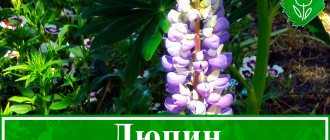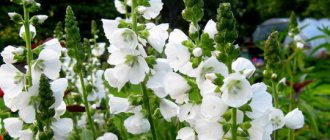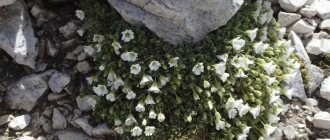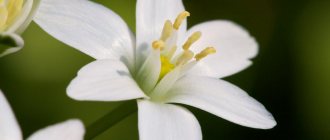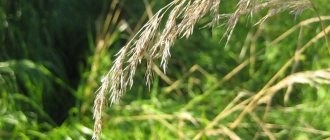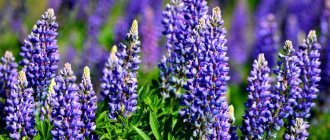The fragrant shrub or thyme bush (Thymus) is a representative of the largest genus of the Lamiaceae family. The Russian name “thyme” comes from the Greek word “incense,” meaning “fragrant substance.” In some cases, thyme and thyme are the same plant, but only when it comes to creeping thyme. This plant is popularly known by many other names: Bogorodskaya grass, lemon scent, flypalm, incense, chebarka, heather. The birthplace of this plant is North Africa; the first mentions of it can be found in the works of Dioscorides and Theophrastus. This genus includes several hundred species; in nature they can be found in Greenland and Eurasia. This culture is in demand in the perfume and food industries, as well as in medicine.
Brief description of cultivation
- Sowing . Thyme is sowed for seedlings in mid-March. The plant is planted in open soil from mid to late May.
- Bloom . The bushes bloom from June to August. In this case, the bushes bloom for the first time in the second year of growth.
- Illumination . The site can be sunny or in partial shade.
- Soil . Nutritious, light, drained, alkaline or neutral.
- Watering . Water sparingly only when necessary, but when the bushes bloom, watering should be more frequent. If there is a lot of rain in the summer, you won’t need to water the thyme.
- Fertilizer . Bushes need to be fed only when grown on poor soil; horn flour should be added to it, and the surface of the bed should be covered with a layer of mulch (rotted compost).
- Trimming . Shortening the stems by 2/3 is carried out at the beginning of the spring period, and also after the bushes have flowered.
- Reproduction . By cuttings, seeds and dividing the bush.
- Harmful insects . Aphids, sand worms, meadow moths and weevils.
- Diseases . With increased soil moisture, bushes are affected by fungal diseases.
Where can you collect thyme?
In Russia, most thyme grows in Crimea, Tatarstan, the Krasnodar region, the Caucasus and the Urals. You can also find the fragrant plant in the Moscow region, Siberia, Leningrad or Nizhny Novgorod regions. Thyme is an unpretentious crop; it can be found in almost all open sunny areas. Where does thyme grow:
- At the edge of the forest;
- In meadows and fields;
- On the steppe area;
- In dry forests;
- Near the foot of the mountains;
- In pine forest sands;
- On open sunny slopes.
Thyme herb: description, where it grows, how to collect
The plant is harvested twice a summer. The first collections are recommended to be carried out during the flowering period (July), the second time when fruit ovaries appear (third decade of August).
On a note. The most favorable time for collection is considered to be the first period when the plant blooms. At this time, thyme has its strongest healing properties.
On a large plantation, harvesting is carried out using special equipment (mower); for self-collection, you need to prepare garden shears and pruning shears.
The branches are cut along with the flowers, 15 cm away from the surface of the earth. If you cut the plant at the root or pull it out from the ground, then there will be no more harvest on this plantation.
Thyme is a plant from the Red Book. The growing area is shrinking sharply every year, but it is still collected for personal use; most often, dried thyme is used to treat diseases.
Features of thyme
The height of thyme bushes can reach about 0.35 m. Woody stems can be ascending or recumbent, and flowering herbaceous branches can be erect or ascending. The woody root is a taproot. Depending on the type, the leaf blades of a given plant may differ in size, shape and veining. Most often they have short petioles, and the plates themselves are hard and leathery; less often they are entire-edged and sessile, while in the Far Eastern species the leaves are serrated. Elongated or capitate inflorescences are located at the tops of the branches; they consist of flowers of pink, white or purple color. The fruit is a capsule containing 4 spherical nuts that have a bitter taste and pleasant smell; they are used as a seasoning called “black thyme.” Flowering of this plant is observed from June to August. Fruit ripening occurs in August–September. This culture is related to the following plants: lavender, oregano, rosemary, hyssop, basil, motherwort, sage, lemon balm and mint. This plant has become very popular among gardeners in recent years; today it is grown in the garden almost as often as celery, dill and parsley.
SPICE PLANT THYME, From A to Z,
What does thyme look like?
Bogorodskaya grass, boron pepper, motherwort are the popular names of the plant. Creeping thyme is the official name for thyme; a photo and description of the plant will allow you to recognize it and not confuse it with other herbs.
Thyme is a subshrub, no more than 35 cm high. The stem is hard, woody, covered with brown bark, spreading along the surface of the ground. It often takes root in areas where shrubs grow. The leaves are small, located opposite each other, attached with a short petiole. The leaves have an oblong shape. Along their outer edge there are thin white cilia.
The flowers are small, usually pink or pinkish-purple. They are collected in loose cone-like inflorescences. After flowering, a dry fruit is formed, which breaks up into 4 spherical nuts.
Thyme actively blooms in June-July. The shrub can grow in one place for up to 30 years. The plant reproduces by seeds or shoots.
Planting thyme for seedlings
What time to sow seedlings
Thyme seeds are sowed for seedlings in mid-March. Since the seeds are very small, before sowing it is recommended to combine them with river sand in a ratio of 1:3. The container is filled with soil mixture for cacti, and a third of the black soil must be added to it. After this, the seeds are evenly distributed on its surface. For sowing, you can also use a substrate consisting of peat and sand (1:1), but it must be disinfected. There is no need to bury the seed into the soil mixture; it is only covered with a thin layer of sand on top. Then the crops are carefully watered with a fine sprayer, and the container is covered with glass on top and placed in a well-lit and warm place.
Rules for growing seedlings
Seedlings must be grown indoors for at least 8 weeks. It is best to plant plants in open soil at the age of 70 days. After the seedlings appear, they are placed in a cooler place, and the glass is removed. Watering is carried out using a sprayer immediately after the top layer of the substrate has dried a little. The room where the seedlings are located must have good ventilation, but they must be protected from drafts.
Thyme or thyme - how to grow seedlings from seeds and plant (thyme thyme or thyme)
Growing on a windowsill
Thyme can be grown indoors. To do this, you will need a pot with a diameter of no more than 15 centimeters; at its bottom you need to make a drainage layer, the thickness of which should be from 20 to 30 mm. The drainage from above can be covered with a layer of soil mixture (see composition above). The soil mixture must be moistened, and several seeds must be evenly distributed over its surface; the top should be covered with a half-centimeter layer of substrate, which is then moistened with a spray bottle. The container is covered with film or glass, then it is placed on a south-facing window, while the crops are protected from direct rays of the sun. The seed material has good germination. After the seedlings appear, the shelter must be removed. Watering should be moderate, it is carried out after the top layer of the substrate has dried. After 8 weeks, all weak seedlings must be removed, only the most developed ones should remain. To get fragrant and fresh greens for as long as possible, you need to cut them often enough, and try to prevent the bushes from blooming.
Growing at home in a pot
It is worth knowing that thyme is also suitable for growing in pots at home. However, he feels better on the terrace or balcony than at home.
Sowing in pots from seeds at home
Thyme grown at home in a pot on the kitchen windowsill requires slightly different steps. At the end of March - beginning of April, you need to sow the plants by sticking 3 seeds into one pot. From the end of May, seedlings should be placed outside, having previously been hardened off. Around November, the pots should be removed indoors. In winter, store thyme in a room with a temperature of 10-15 ° C, limiting watering so that the bushes have the opportunity to go into a dormant state.
Care
Plants grown in containers need to be watered regularly and kept in a light position.
In winter, they should be protected from frost, because in such conditions thyme quickly freezes. In winter, care should be taken to place thyme pots in a room with a temperature of 10-15 °C, which will make it easier for them to go dormant. During the thaw, the plant should be watered carefully, because if you leave too much moisture in the pot, it will not survive until spring.
Thyme grown in a pot can be harvested all year round. In autumn and winter the plant does not grow, so you can only trim individual shoots.
Planting thyme in open ground
What time to plant
Planting thyme seedlings in open soil should be done from mid to late May. The area suitable for planting should be well lit. It can also be grown in a shaded area, but such bushes develop poorly and become very elongated. The soil should be well-drained, nutritious, light, alkaline or neutral. If grown on clay and wet soil, the bushes may be prohibited; therefore, it may be necessary to organize good drainage.
Preparing the site for planting should be done in the autumn. First, you need to remove all plant residues from it, then dig it up, and rotted manure or compost, as well as potassium-phosphorus fertilizer, should be added to the soil. In the spring, before planting, the area must be loosened, and the soil must be spilled with a urea solution (20 grams per 1 liter of water). When planting bushes, a distance of 20 to 25 centimeters should be maintained between them, while the row spacing should be from 0.4 to 0.5 m.
Creeping thyme - growing conditions
In order for creeping thyme to grow in a flowerbed or in any other landscape form at a summer cottage, you must:
- Grow seedlings or purchase ready-made ones. In this case, in the first year the plant will actively increase its green mass, and starting from the second year it will bloom and bear fruit.
- Choose the right plot and prepare it. Carry out the landing procedure, following simple rules.
- Care for the plant by performing basic gardening procedures.
Where to plant creeping thyme?
In order for the creeping thyme flower to bloom well for more than one year, it is important to choose the right location. The best option:
- Open sunny area. In rare cases, partial shade is also suitable, but the number of peduncles will be more meager.
- The grass feels good on light and loose soils, so sand is first added to heavy clay and loamy soils.
- It is important for the gardener to monitor the acidity level of the soil in the area. This can be done using regular litmus paper, sold at any gardening store. If the soil is acidified, then chalk or lime is added to it before planting thyme.
Thyme care
To prevent stagnation of water in the root system of the bushes and to prevent crusts from appearing on the surface of the soil, it must be loosened regularly. It is necessary to weed the bed in a timely manner, pulling out only the emerging weeds. To reduce the amount of weeding and loosening, the surface of the area should be covered with a layer of mulch (compost). You also need to trim the bushes regularly; this is done in early spring or after the thyme has faded. It is necessary to shorten the stems by 2/3 before lignification begins. Bushes need to be pruned to make them compact and denser.
How to water
This culture reacts extremely negatively to stagnation of liquid in the roots, but is drought-resistant. In this regard, watering thyme should be carried out only when it is really necessary. When the bushes bloom and young stems begin to grow, you should start watering them a little more often. If it rains regularly in the summer, then there is no need to water the bushes at all.
Fertilizer
Thyme does not particularly need fertilizing, especially if all the necessary fertilizers were added to the soil before planting the thyme. Only if the soil in the garden bed is very poor will the plants need feeding; for this, the surface of the garden bed should be mulched with rotted compost or horn flour can be added to it.
What can you grow after thyme?
Since thyme does not need a large amount of nutrients and after it the soil is not depleted, as, for example, after potatoes, cabbage or celery, any plants can be cultivated on the site after it, but they should not be representatives of the Lamiaceae family.
Bogorodskaya herb in your garden How to grow thyme and thyme
Growing and care
There are two ways to grow creeping or lemon-smelling thyme: in the garden, in a flower garden, and in a pot on your home windowsill. Both methods require preparing the appropriate substrate, choosing the right position and caring for the plants. Cultivation is not difficult, and the numerous properties of this herb and its use compensate for all difficulties.
Fertilizing, watering, weed control
Thyme does not require much care. The main thing in growing it is to take care of the appropriate position and substrate. The soil should be loosened after each grass harvest.
Thyme is quite sensitive to weed infestation; if there are a large number of weeds, its growth and development may be suppressed. During the growth of the bushes, it is necessary to regularly weed and loosen the substrate to ensure access of oxygen to the roots.
Rotted compost is better suited for feeding thyme. Thyme does not need fertilizing with mineral fertilizers. The plant also needs regular watering. Thyme is quite resistant to temporary drought, and as long as the temperature is not too high and the lack of precipitation is short, the bushes do not require additional moisture.
Attention! Thyme should not be planted on soils that are too wet; if it is regularly soaked, it turns black and rots.
Collection of greenery, pruning
Thyme is grown in gardens for 3-4 years. At home, thyme herb can be collected from the garden from spring to autumn. Harvesting can be done before flowering begins, although a more appropriate date would be the beginning of flowering.
The first pruning of thyme leaves begins early so that the bushes become dense. Regular pruning improves branching, young shoots become soft, rich in beneficial ingredients and are ideal for use, creating a harmonious bush shape. The last pruning is done no later than mid-August. Later, shoots can also be cut back for current consumption, but late radical pruning will lead to the development of young shoots that will not become woody until winter.
It is better to trim thyme with scissors. The highest content of valuable ingredients in the green parts of the plant accumulates shortly before noon. This must be remembered, especially if the thyme is intended for tea or for flavoring dishes.
The collected thyme herb should be dried in a dry, warm, ventilated place, without light that causes discoloration of the leaves.
After collection, the grass is tied in bunches and dried. For drying, you can use cold or heated air dryers, but the temperature of the supplied air should not exceed 35 °C to avoid loss of essential oils.
After drying, the leaves are removed from the shoots, since the woody stem is unsuitable for consumption or medicinal purposes. The dried raw materials have a pleasant aromatic smell and a bitter-spicy taste.
Rejuvenation
Every few years it is useful to rejuvenate the thyme by dividing a large bush into smaller ones and planting it in a new place. It is also recommended to periodically trim old thyme stems, which allows the plant to bloom more profusely. This is done in the spring; shoots are cut to 1/3 of the height.
Diseases and pests
Thyme is not free from diseases and pests. Most often, plants suffer from fungal diseases:
- sprout rotting caused by the fungus Fusarium;
- gray mold caused by the presence of Botrytis cinerea Pers.
Currently, a chemical preparation - Signum 33 WG - is intended to protect thyme from fungal diseases.
Pests that can attack the plant:
- planthoppers Jassidae – cause spot discoloration;
- ground flea beetles Halticinae - gnaw small holes in leaves.
Wintering
Thyme is native to temperate climates and is not adapted to harsh winters, so it freezes when there are high temperature changes (below -16 °C). For this reason, a sunny place should be allocated for it, warm and protected from the wind, and in the coldest regions of the country, cover the bushes with leaves or pine needles for the winter, or cover the base with compost, a layer of bark, straw or agrofibre.
Pests and diseases of thyme
Thyme pests
This culture is highly resistant to various diseases and harmful insects, since it contains essential oil. However, if you do not follow the agrotechnical rules of this crop, then sand slowworms, meadow moths, aphids and weevils can settle on the bushes.
meadow moth
Caterpillars of the meadow moth gnaw the underside of the leaf blades, while they entwine them with cobwebs. They also damage flowers and stems. For preventive purposes, you need to ensure that there are no weeds on the site, and in the autumn it should be dug up. To get rid of such a pest, the bushes are sprayed with a solution of Decis.
Sand slugger
The sandworm is a black beetle that reaches 0.7–1 centimeters in length; it infects the above-ground parts of the bush. To get rid of such a harmful insect, you will need baits that poison with pesticides.
Aphid
Aphids are sucking insects; they suck out juice from young stems and leaf blades, biting them. To destroy them, drugs such as Antitlin and Biotlin are used.
Weevil
Weevils injure flowers by laying larvae in the buds. To get rid of them, the bushes are sprayed with a solution of Fitoverm, which does not harm humans.
Diseases
If you care for such a crop incorrectly, or rather if you water the bushes too much, then this can cause the development of a fungal disease. To cure the affected bush, it is treated with a fungicidal drug: Ridomil, Horus, Fundazol, Topaz or another agent with a similar effect. But it is better to try to prevent the plants from getting sick than to treat them for a long time. And for this it is enough to water the thyme correctly.
Choosing a growing location and soil
Thyme, like any plant, has certain growing requirements that must be met to ensure its best development. In the garden this should be a place:
- sunny, bright;
- warm;
- protected from the wind.
Ideally, the sun should shine on the plant for at least half a day. In addition to light, the plant needs a lot of heat. Therefore, it readily grows near walls and stones, which heat up and then return solar energy.
Attention! It is better to choose a higher place for growing thyme. This plant does not like soaking. It is important that plants, especially young ones, are not flooded in the spring. Especially early varieties that lie on the ground like moss.
The soil for growing thyme should be:
- fertile;
- air;
- rich in calcium;
- rich in humus and essential nutrients;
- permeable, preferably sandy;
- well loosened;
- warm.
The plant will also cope with weaker soils.
A limestone substrate is excellent for growing thyme. The soil intended for planting should not be acidic (if necessary, liming may be required before planting) and should not be too wet or too dry, in such areas the plants will grow very poorly or die.
The plant suffers greatly from weeds; it is most vulnerable at the very beginning of cultivation, when young seedlings have not yet had time to take root and branch well. Therefore, before planting thyme, the area should first be thoroughly cleared of weeds and dug deep.
Good predecessors for thyme (cultures after which it is better to plant):
- roots;
- vegetables;
- rape;
- green legumes.
Despite the fact that thyme does not have high nutritional requirements, before cultivating it, mineral fertilizers can be added to the soil in an amount of approximately 400-500 g/area P₂O5, 500-600 g/area K2O (before planting on a plantation) and 400-600 g/acre N in two doses before planting and for fertilizing.
Thyme in a pot on a windowsill in an apartment should also be grown on fairly fertile soil and preferably placed on a southern windowsill. From May you can take it outside, making sure that it does not freeze.
Types and varieties of thyme
Thyme has a large number of different species and varieties. The most popular among gardeners are creeping thyme and common thyme.
Common thyme (Thymus vulgaris), or medicinal thyme, or officinalis thyme
This species is native to the Northwestern Mediterranean. This plant with flowering stems reaches a height of about 15 centimeters. The leaf blades have pubescence on the underside. The color of the flowers is light purple, almost white. This species has several varieties or subspecies:
- Alba - flower color is white;
- Splendence - flowers are carmine red;
- Elfin is a dwarf bush, reaching no more than 50 mm in height; it forms a compact, dense cushion with a diameter of about 15 centimeters.
A composition made up of subspecies with flowers of different colors looks great on the site.
Creeping thyme (Thymus serpyllum)
This plant is also called savory or thyme; under natural conditions it is found in Siberia, Western Europe, the Far East and the European part of Russia. This perennial plant reaches a height of about 15 centimeters. The stems are creeping, cylindrical in shape, with protruding hairy shoots in their lower part. The shape of the petiole leaf plates is lanceolate, and they reach 10 mm in length. The height of the peduncles is about 15 centimeters. The opening of capitate inflorescences is observed in July, the flowers are colored lilac-pink. This species has been cultivated since the 16th century. Among the varieties of this species, there are those whose flowers are painted white, carmine and pink, and there is also a form with variegated foliage. This species is cared for in the same way as a ground cover plant.
Early thyme (Thymus praecox)
This type has 2 varieties:
- Minor. This shrub is characterized by slow growth and is perfect for alpine hills. Its inflorescences are small, as are the pubescent leaf plates.
- Pseudolanuginosus. This ground cover variety forms a floral carpet, with so many flowers that it is impossible to see the foliage because of them.
Lemon thyme (Thymus x citriodorus), or lemon-scented thyme
This plant is a natural hybrid of flea thyme and common thyme. In nature, it is most often found in the southern part of France. The height of the peduncles is about 30 centimeters, the inflorescences are colored pinkish. The variegated leaf blades are round in shape. This hybrid has been cultivated since 1595. When growing such thyme, its adult bushes must be provided with timely pruning, and they must be covered for wintering. The most popular varieties are:
- Golden Dwarf and Bertram Anderson - there are spots of yellow color on the surface of the foliage;
- Silver Queen - a white border runs along the edge of the sheet plates;
- Golden King - green foliage has a yellow edge.
Subarctic thyme (Thymus subarcticus)
In nature, this species is found in the eastern and northern parts of Europe on rocks, in forests and along the banks of various reservoirs. The inflorescences of such a low-growing shrub are slightly loose; they contain bell-shaped flowers of a dark purple color. The edges of small dense leaf plates are curved down. The bushes bloom in July–August. The smell of this plant is pleasant and strong.
Japanese thyme (Thymus japonicus)
In nature, this species is found in Japan, Mongolia, the Far East, Korea and Northern China on rocks near river and sea shores. The small leaf blades of this subshrub have an elliptical shape. The semi-whorled inflorescences include pink flowers, which open in July–August.
Flea thyme (Thymus pulegioides)
The shape of the leaf blades of this plant is elliptical. Purple-pink flowers are collected in dense heads. Their opening is observed in June.
Siberian thyme (Thymus sibiricus)
The homeland of this steppe species is Eastern Siberia and Mongolia. This plant blooms throughout the summer. The bush is decorated with many pink flowers.
Dorfler's Thyme (Thymus doerfleri)
The homeland of this species is the Balkan Peninsula. It is not very popular in culture. This species is quite interesting, but it is not highly resistant. In May–June, pinkish flowers open.
Beneficial features
Thyme is used not only in folk medicine, but also in pharmaceuticals for the preparation of medicines. It is used to treat diseases and as an immune booster.
It is considered an effective medicine for bronchial diseases. To treat a prolonged cough, a decoction or infusion is prepared from the herb.
It is prescribed for problems with the gastrointestinal tract (heartburn, gastritis, indigestion, diarrhea, flatulence), and for gynecological diseases.
Thyme decoction helps with toothache
The juices of the plant contain bactericidal substances, so decoctions help with stomatitis or toothache.
Compresses and lotions with thyme infusion are effective for bruises and rheumatism.
In cosmetology, thyme is used to fight acne and dandruff.
On a note. Essential oils have a calming effect, so aromatic tea with thyme helps with headaches and depression. If you spread grass in your apartment or make a cloth bag with thyme, then harmful microorganisms and air pollutants will disappear, and the house will have a pleasant smell of fragrant grass. Essential oils repel moths.
Thyme, collected in the field or grown in the garden, is equally beneficial for human health. Growing medicinal herbs at home will not cause any trouble for the gardener. Its beautiful decorative appearance will decorate the garden, filling it with the spicy aroma of meadows.
5 2 votes
Article rating
Properties of thyme: harm and benefit
Medicinal properties of thyme
The above-ground part of thyme has healing properties. Infusions and decoctions with antimicrobial, enveloping and expectorant effects are prepared from it; they are used to treat whooping cough, tracheitis, sinusitis, bronchitis, tonsillitis, sinusitis, bronchopneumonia. Such drugs help to liquefy mucus and stimulate the activity of the bronchial glands.
Preparations made from thyme are recommended for use for neuroses, neuralgia, diseases of the gastrointestinal tract (enterocolitis, dysbacteriosis, dyskinesia, atony, intestinal spasms and flatulence). This culture has also shown high efficiency in the fight against pathogenic microflora, which is insensitive to antibiotics. If you use a pillow filled with thyme to sleep, then headaches and insomnia will no longer bother you. The composition of such herbs includes bitterness, gum, essential oil, tannins, organic pigments and minerals. Essential oils “white thyme” (fresh) and “red thyme” (aged) have a warming effect on the skin; they are used for cosmetic and medicinal purposes. But when using such products, you must strictly adhere to the instructions and dosages. It is best to consult with a qualified specialist.
The healing properties of THYME (Thyme) - a natural stimulator of the body's defenses!
Contraindications
Since the herb contains a large amount of thymol, it cannot be used for heart and kidney failure, stomach and duodenal ulcers, especially in the acute stage of the disease. During pregnancy, this herb is also contraindicated because it can cause uterine contractions. With prolonged use of thyme preparations or in case of overdose, there is a high probability of developing hyperfunction of the thyroid gland (Graves' disease). Such drugs should not be used to treat children under two years of age.
How to grow thyme from seeds (video)
Dried and fresh raw materials are boiled and consumed for:
- blood pathologies;
- neuralgic ailments;
- hypotension;
- joint inflammation;
- cardiac disorders;
- insomnia;
- loss of appetite.
Despite the fact that the creeping plant brings many benefits, it has contraindications for gastritis and duodenal ulcers. It is not recommended for pregnant women to take medications based on it.
Use in landscape design
Cultivated thyme is in demand by gardeners for its decorative properties and unpretentiousness. Most often it is used for arranging rocky gardens, as a frame for group plantings, as a living border on a Mediterranean-style site, as a filler for free areas between slabs or beds. Compositions made from several varieties of thyme are also popular. For example, a combination of variegated forms with an anthocyanin-colored variety. This mixborder does not lose its decorative effect even after flowering.
Thyme is often used as a grass alternative for lawns. Its original flowering, pleasant aroma and unpretentiousness allow summer residents not to worry about the state of the green area on the site during their long absence. Thyme perfectly tolerates the lack of moisture, the influence of direct sunlight, and is resistant to mechanical stress.
Thyme plays an important role in the design of the borders of paths and paths. A soft lilac carpet looks extraordinary and erases the boundaries of everyday life in landscape design. Such a simple, at first glance, decoration is indispensable for rockeries, rock gardens and rocky gardens.
Combination with other plants
The noble greenery of thyme creates an attractive backdrop for many garden plantings with bright flowers. Among them:
- peony;
- chrysanthemums;
- roses;
- lilies;
- tulips;
- daffodils and others.
In a mixborder, thyme is planted between plants as a spreading carpet or as a frame for a composition. In rock gardens and other stone ensembles, garden plantings are often “neighborhood” with conifers. These can be both large trees (pine, spruce, thuja) and low-growing representatives of the crop (short varieties of juniper, dwarf pine).
